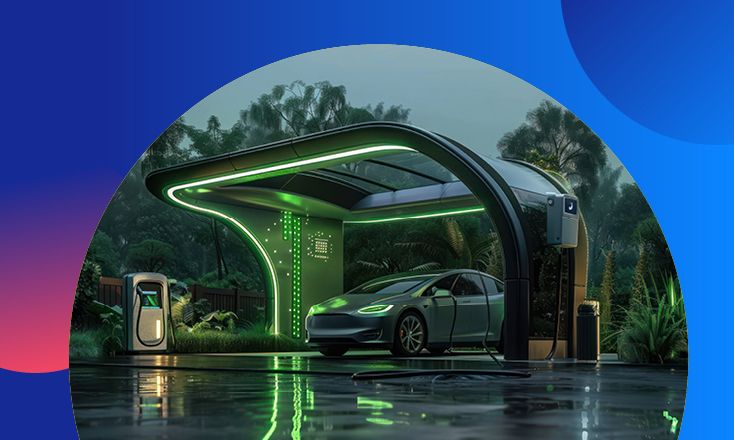EV Charging at Gas Stations: Loyalty Strategies That Work
- Published
- 9 min reading

How Fuel Retail Loyalty Programs Should Adapt to EV
So your customers are driving electric. Now what? The global switch to EVs is rewriting the entire fuel retail experience. As more drivers swap the pump for the plug, fuel retailers face a critical question: how do we keep customers coming back when everything from dwell time to location preference is changing?
Continue reading to learn:
- What sets EV drivers apart from traditional fuel customers—and why it matters for loyalty
- How to adapt gas stations to EV charging without losing sight of the customer experience
- Why fast charging, great coffee, and smart data are the new power trio
- Real-world strategies from fuel retailers already leading the EV transition
- How to rewire your loyalty program for flexibility, personalization, and long-term relevance
Electric Mobility and Its Impact on Traditional Fuel Retail
Let’s be honest—if fuel retail was a blockbuster movie, the rise of electric vehicles (EVs) is the unexpected plot twist. And fuel retailers? They're right in the middle of a major transformation.

With every electric car that rolls off the production line, the demand for gasoline and diesel inches lower. What once felt like one of many loyalty trends now has a front-row seat in every boardroom discussion.
According to our 2024 market research, 64% of consumers care about sustainability when choosing where to shop. But delivery fleets, public transport systems, even government motor pools are also going EV. And now, fuel retailers, whose business model has long been built on liters pumped, are staring down a future where that volume is in freefall.
Electric Vehicles: From Niche to Normal
EVs aren’t just coming—they’re here. The numbers don’t lie. In 2024 alone, electric car sales jumped to over 16.6 million globally.

Additionally, in 2024, more than 1 in 5 new cars sold worldwide were electric—22%, to be exact. Norway led the charge with 92%, while China wasn't far behind, nearing the 50% mark.
Meanwhile, the electrification of commercial fleets is quietly transforming “B2B” into “B2E”—business to electric. Amazon, DHL, and countless regional players are switching to EV vans. And when governments step in with mandates and incentives (think tax breaks, ZEV targets, and urban low-emission zones), that transformation gets turbocharged.
So, What Does That Mean for Fuel Retailers?
It means the revenue model is on shaky ground. Selling fuel won’t cut it. Foot traffic will probably drop, and the old levers—discounts on snacks, car wash upsells, coffee combos—won’t be enough to plug the revenue leak.
But here’s the upside: customer loyalty isn’t dead. It’s evolving. And for brands willing to pivot, this could be the start of something even bigger—a way to become more relevant to consumers.
Because when drivers spend 30 minutes charging instead of 3 minutes filling up, that’s not a problem. It’s an opportunity.
Competing in the Crowded World of EV Charging
Today’s EV driver can “fuel up” just about anywhere. Home charging is convenient, cheap, and overnight. Public EV chargers? Everywhere, from IKEA to airport parking lots. In 2023, almost 5 million publicly accessible light-duty vehicle charging points were in place. In short, EV drivers are spoiled for choice—and traditional fuel stations are just one of many stops on the map.
But fuel retailers don’t need to win the infrastructure war—they need to win the experience war.
Think:
- Comfort-first zones with Wi-Fi, seating, and coffee that doesn’t taste like regret
- Bundled perks: free coffee for every 30-minute charge, discounts on snacks, kids' play areas—turn downtime into "me-time"
- Loyalty mechanics built for dwell time: gamify wait times, offer bonus points for off-peak charging, or partner with local businesses to cross-reward
Big Oil Goes Electric
Just look at Shell’s Recharge, BP Pulse, and TotalEnergies’ EV networks. These aren’t side hustles—they’re billion-euro bets. They're integrating fast chargers with existing services, upgrading convenience stores, and building digital loyalty layers that actually feel rewarding.

Adapting Loyalty Programs for EV Drivers to Enhance Customer Experience
Charging an EV isn’t like filling a tank—it’s like charging your phone. You top it up while you’re doing other things.
- Opportunistic Charging: Think of EV drivers as “energy grazers.” They plug in at work, while shopping, during a lunch break. Convenience is key—but it’s not about speed, it’s about stacking value into downtime.
- Range Anxiety & Top-Ups: Unlike fuel drivers who push until the last drop, EV users prefer to keep their charge high. Loyalty perks that reward frequent, small top-ups or offer charging discounts for “maintaining high state-of-charge” can tap directly into this psychology.
- Location and Relaxation: While petrol customers want in-and-out speed, EV drivers are parking for 20–40 minutes. So they seek chargers near experiences—cafes, shopping centers, scenic rest stops. Loyalty programs should reflect this with cross-partner benefits that turn charging into a lifestyle moment.
Why Fast Charging Is the New VIP Lounge
AC charging is the cheap economy seat. DC fast charging? That’s business class—and EV drivers will go out of their way for it.
- Meeting the Need for Speed: DC fast chargers can get an EV from 20% to 80% in about 20 minutes. Loyalty programs should highlight “fast charger access” as a premium benefit, even gamifying it—think tiered status for fast-charging frequency or exclusive access during peak hours.
- The Strategic Hook: With time-sensitive drivers (fleet, gig economy, or parents on a schedule), fast charging can be the #1 differentiator. Bundle loyalty perks with guaranteed slots or pre-booking for these customers.

Turn Charging into a Green Badge of Honor
Let’s not forget: EVs are a sustainability choice. And today’s consumers want brands that walk the walk.
On average, electric cars in Europe produce over three times less CO₂ than their petrol-powered counterparts. According to the same source, even in one of the least favorable scenarios—where an EV is manufactured in China (with higher-emission battery production) and driven in Poland (where electricity generation is still coal-heavy)—it still emits 37% less CO₂ over its lifetime than a comparable petrol car.
- Sustainable Loyalty = Emotional Loyalty: Reward drivers for choosing greener options—charging at off-peak hours, using solar-powered stations, or opting into petrol station loyalty programs with carbon offset.
- Certifications Matter: Investing in LEED-certified buildings or WELL-accredited facilities doesn’t just look good on paper. It builds trust. Don’t bury it in the fine print—make it part of your brand story and loyalty messaging.
Going Digital-First Isn’t Optional—It’s Expected
If your charger isn’t on Google Maps, does it even exist? EV drivers live by their phones—and loyalty needs to meet them there.
- Be Where They Are: Make sure your locations are visible on EV charging apps (PlugShare, ChargePoint, Google Maps). Better yet, integrate real-time availability into your loyalty app.
- Own the Experience: Build a proprietary app that lets users find stations, track usage, collect points, and get personalized offers—all from the same dashboard. Bonus: tie rewards to app engagement, not just spend.
Personalized Loyalty
64% of consumers want to receive personalized offers or recommendations.
EV drivers aren’t a monolith. Some charge daily, some weekly. Some charge at 2 p.m., others at 2 a.m. That’s gold for marketers—if you know what to do with it.
- Smart Segmentation: Use behavioral data to create segments: night chargers, road trippers, city commuters. Then tailor offers: double points during their usual hours, or personalized maintenance perks for high-mileage drivers.
- Reward Their Rhythm: Not every perk needs to be a discount. Personalization means curated playlists, push notifications with weather-adjusted battery tips, or birthday gifts based on drive history.
Coffee May Matter More Than Charging Speed
People don’t just charge their cars—they charge themselves. That’s why the surrounding environment matters.
- More Than a Forecourt: Think coffee shops, quiet corners, clean restrooms, even coworking pods. Loyalty can bring it all together—like “charge & chill” bundles or bonus points for café spend during a charging session.
- Real-World Inspiration: Some Shell and BP locations are turning into lifestyle hubs—adding brand-name cafés, gym tie-ins, even Amazon pickup lockers. The message? Make the station a destination.
Don’t Forget the Nuts and Bolts
Fast charging isn’t plug-and-play. It requires serious investment in grid upgrades, space, and sometimes even permitting.
- Reward the Wait: If you’re piloting new fast chargers or rolling out upgrades slowly, use loyalty incentives as a bridge. Reward patience. Offer free snacks or high-point bonuses during pilot phases.
- Transparency Builds Trust: Let customers know what's coming. Tease new chargers or features through your app or loyalty comms. Build anticipation—like you would for a product launch.
Growing an EV Ecosystem
New EV models are hitting the road every month—from sleek sedans to rugged SUVs and fleet workhorses. Behind the scenes, battery tech is leaping forward, smart grids are getting smarter, and governments are throwing serious weight behind EV infrastructure. In short: the EV ecosystem is expanding fast, and fuel retailers can’t afford to watch from the sidelines.
Purchase grants for zero-emission vehicles have significantly boosted adoption rates and even influenced the second-hand EV market, as seen in Germany.
Here’s the strategic goldmine—location. Fuel stations already sit at prime crossroads, highway exits, and urban corners. In the EV world, that’s powerful real estate. But to thrive, they need to go beyond just charging.
Imagine them as multi-service hubs: coffee shop, mini-market, charging lounge, parcel pickup, and yes—charging. All rolled into one sticky, loyalty-friendly experience.
How to Plug In (and Stay In)
- Invest in fast, reliable chargers that meet modern expectations.
- Partner up with EV makers, energy tech firms, city planners.
- Wear your green badge proudly. Emphasize your role in sustainability, from solar roofs to clean energy sourcing.

Adapt Your Gas Station to EVs: Future Predictions
Loyalty for a Moving Target
Fuel retailers will need to think in long arcs. The transition to an all-EV customer base is about behaviors, expectations, and habits that keep evolving. Loyalty programs can’t be static. They’ll need to flex with the times: modular, data-driven, and ready to plug into new touchpoints we haven’t even imagined yet.
Think: dynamic rewards that respond to energy prices, real-time travel needs, or even grid demand. And remember: according to our research, nearly 70% of consumers view dynamic pricing as either 'somewhat' or 'very' positive.
Tech That Changes the Game
Emerging tech like wireless charging and autonomous vehicles isn’t sci-fi anymore. By 2025, an estimated 63% of all vehicles sold worldwide will feature Level 2 autonomy or above. Imagine loyalty perks tied to where your self-driving car chooses to charge. Or automatic point redemptions triggered by wireless, in-ground chargers at your local hub.
Convert Gas Stations to EV Charging Sites
The rise of EVs has made one thing clear: traditional fuel stations must evolve or risk fading into the background. And while the technical challenges are real, so are the business opportunities for fuel retailers who move early and smartly.
If you're ready to adapt your gas station to EV trends, or wondering how to position your brand in the evolving mobility ecosystem, now’s the time to talk.
At Comarch, our loyalty solutions for fuel retail and skilled specialists are helping energy leaders turn infrastructure into experience—and experience into loyalty. Reach out today and let’s build what’s next!
FAQ
1. Will gas stations go away?
Not entirely—but they’ll change. As EV adoption grows, gas stations will shift toward offering EV charging, convenience services, and digital experiences.
2. What is the future of EV charging stations?
EV charging stations will become faster, smarter, and more integrated with retail and loyalty programs, offering drivers seamless, value-rich stops.
3. What are the benefits of EV charging stations for businesses?
They attract new customers, increase dwell time, boost ancillary sales, and help position your brand as forward-thinking and sustainable.


